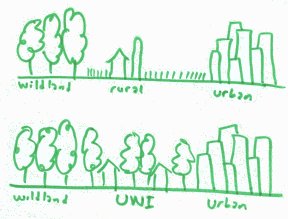Lecture: The Urban-Wildland Interface
A video of this lecture is available upon request.
Overview
This presentation was a guest lecture in Prof. John Rogan's course about wildfire. I spoke for half an hour about the urban-wildland interface and the problems it presents for managing wildfire.
In the first part of my lecture, I introduced the concept of the "urban-wildland interface" (UWI). My objectives were for students: 1) to understand what the UWI is and how it differs from traditional rural land, in terms of the appearance and structure of the landscape and the occupations of its residents, 2) to know in what places and what historical period the UWI has become important, and 3) to be able to name several factors that caused the development of the UWI.
In my introduction, I motivated students by stating that I would help them understand why the UWI is so important to the field of wildfire management, and that I would offer one theory to explain the conflicts over fire that it raises. This depended on the fact that the students had encountered the term and its definition in their past reading, and therefore I would be filling in a gap in their understanding.
I used at least three methods to engage students. I began the talk by asking them to give me a definition of the UWI and predict where it would be found. This allowed me to situate my starting point in the context of things they already knew. I then made extensive use of drawing on the board, diagramming the UWI and non-UWI landscapes. This allowed me to appeal to their visual pathway for learning, in addition to the verbal/auditory. Once the concept of the UWI was presented, I made extensive use of class brainstorming -- about the causes of the growth of the UWI, about why the UWI presents challenges for fire management, and about why there are conflicts between stakeholders over fire management in the UWI. This required them to try to connect the idea I had just presented to background knowledge that they already had to come up with explanations.
Lecture notes
Objectives: understand what the UWI is and where it came from, and why it's significant as a fire problem.
1. What is the UWI?

The urban-wildland interface landscape
Draw cross-section diagram of urban-rural-wild. Pre-WWII situation. Structural fires in city, wildfires in wildland, fire management by rural farmers. Decline in econ. for small farmers -> pop. movement into city, big ag takes over
Post WWII cross-section -- rural area partly replaced by UWI. Reversal of pop movement, farmers sell to developers. Key is that UWI is residential -- UWI people don't use land, b/c have urban service sector jobs
Not all UWI residents are rich
Reasons for UWI [get class to generate ideas]:
- Cheap gas and cars make commuting possible
- Subsidies for greenfield development (tax deductions, infrastructure subsidies)
- Aesthetic amenties
- Desire for own home
- Escape from urban crime, pollution
- Gentrification forces poor out -- can't afford city home
2. The fire problem in the UWI
- Combines wildland and structural fire problems
- Difficulty of defending homes scattered in forests
- Exurbia growing in most fire-prone areas
- Impacts on ecology: exotic species and runoff, introducing fire to occluded interface
3. Values and attitudes in the UWI
Differences of opinion – homeowners object to smoke and danger from burns, don't want to clear defensible space
Ask why -- dumb? uninformed? lack resources?
One key reason: difference of values:
- Safety
- Biodiversity
- Aesthetic
- private property
- place attachment